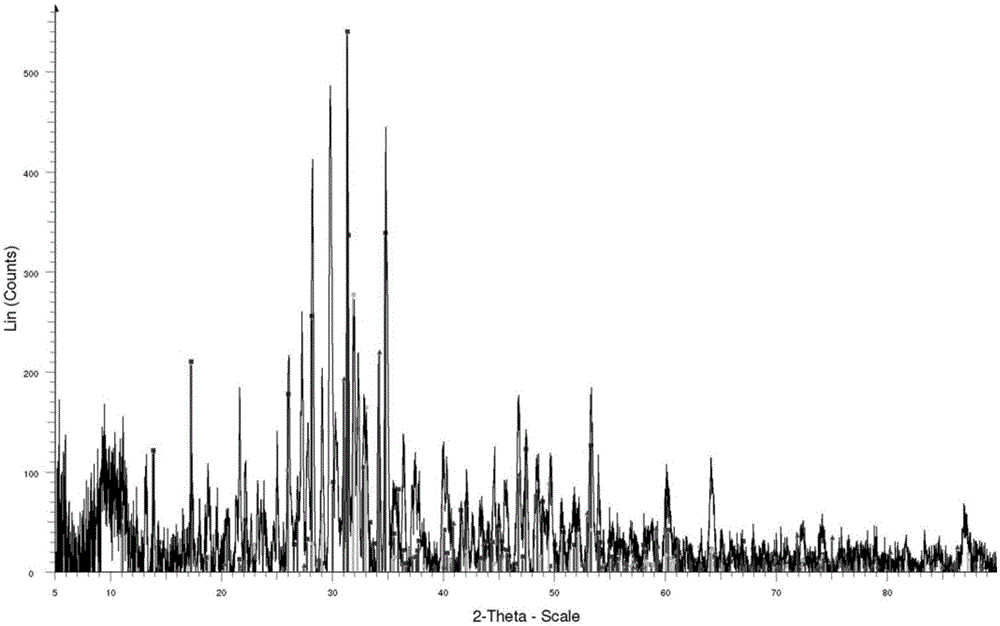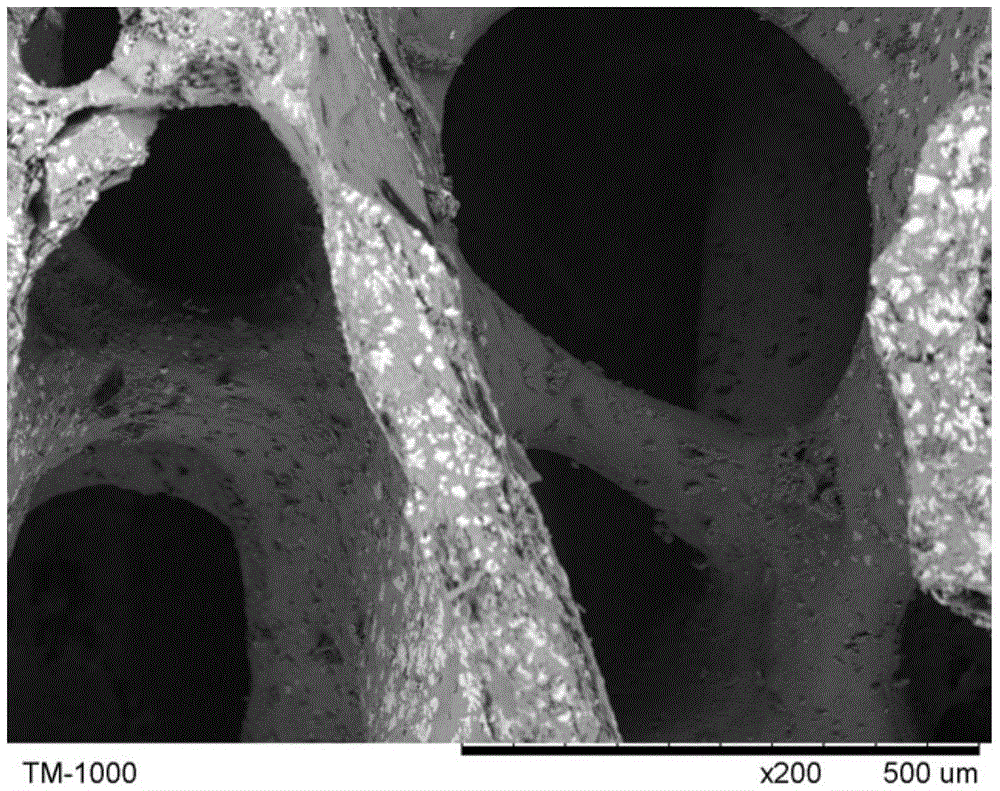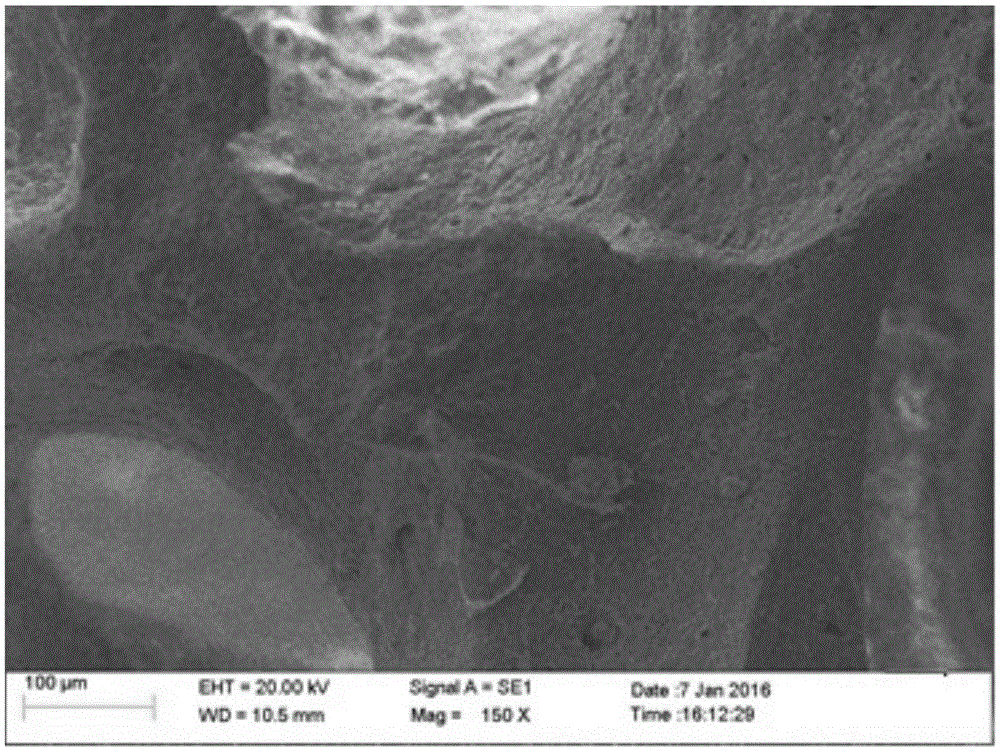Magnesium-containing multiphase porous bioceramic
A bioceramic and porous stent technology, applied in the field of medical materials, can solve the problems of not having good three-dimensional interconnected mesh structure, degradability and biological activity, and achieve the effect of good mechanical strength
- Summary
- Abstract
- Description
- Claims
- Application Information
AI Technical Summary
Problems solved by technology
Method used
Image
Examples
preparation example 1
[0036] (1) cutting bovine femoral condyle cancellous bone into bone strips with a thickness of 0.5-1.0 cm to obtain raw bone;
[0037] (2) Put the raw bone in distilled water and cook it in a pressure cooker (the water temperature can reach up to 116°C±1°C) for 35 minutes, then wash it with 60°C water, repeat this step 6 times;
[0038] (3) Dry the raw bone treated in step (2) in a constant temperature oven at 90°C for 48 hours, then place it in a calcination furnace, and calcinate it at 1100°C (heating rate 10°C / min) for 10 hours, and then cool it with the furnace to obtain beef bone. Calcined cancellous bone mineral porous scaffold.
[0039] The results of X-ray powder diffraction analysis of bovine calcined cancellous bone ore were hydroxyapatite.
preparation example 2
[0041] (1) cutting bovine cancellous bone (bovine femoral condyle cancellous bone) into bone strips and bone blocks with a thickness of 0.5-1 cm to obtain raw bone;
[0042] (2) The raw bone is placed in distilled water and boiled in a pressure cooker for 50 minutes, then washed with pH water, and this step is repeated 5 times;
[0043] (3) Dry the raw bone treated in step (2) in a constant temperature oven at 100°C for 24 hours, then place it in a calciner, and calcinate it at 1000°C (heating rate 10°C / min) for 12 hours, and then cool it with the furnace to obtain beef bone. Calcined cancellous bone mineral porous scaffold.
[0044] The results of X-ray powder diffraction analysis of bovine calcined cancellous bone ore were hydroxyapatite.
preparation example 3
[0046] (1) cutting bovine femoral condyle cancellous bone into bone blocks with a thickness of 1-2 cm to obtain raw bone;
[0047] (2) Put the raw bone in distilled water and cook it in a pressure cooker for 60 minutes, then wash it with water at 60°C, and repeat this step 5 times;
[0048] (3) Dry the raw bone treated in step (2) in a constant temperature oven at 120°C for 12 hours, then place it in a calciner, calcinate it at 1200°C (heating rate 10°C / min) for 8 hours, and cool it with the furnace to obtain a cow Calcined cancellous bone mineral porous scaffold.
[0049] The results of X-ray powder diffraction analysis of bovine calcined cancellous bone ore were hydroxyapatite.
[0050] Embodiment overall scheme 1:
[0051] A: Immerse the bovine calcined cancellous bone ore porous scaffold in the magnesium source-phosphorus source composite solution (the solid-liquid ratio of the bovine calcined cancellous bone ore porous scaffold to the magnesium source-phosphorus source ...
PUM
| Property | Measurement | Unit |
|---|---|---|
| pore size | aaaaa | aaaaa |
Abstract
Description
Claims
Application Information
 Login to View More
Login to View More - R&D
- Intellectual Property
- Life Sciences
- Materials
- Tech Scout
- Unparalleled Data Quality
- Higher Quality Content
- 60% Fewer Hallucinations
Browse by: Latest US Patents, China's latest patents, Technical Efficacy Thesaurus, Application Domain, Technology Topic, Popular Technical Reports.
© 2025 PatSnap. All rights reserved.Legal|Privacy policy|Modern Slavery Act Transparency Statement|Sitemap|About US| Contact US: help@patsnap.com



